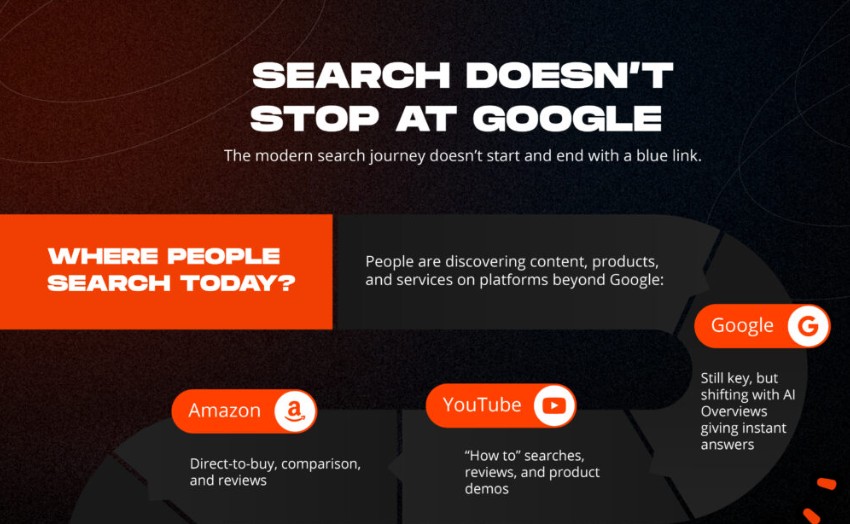Search Doesn’t Stop at Google — It’s Just a Start
In today’s digital landscape, search no longer begins and ends with Google. The journey of discovery now zig-zags across platforms—from social networks and maps to marketplaces and AI assistants. If you’re solely focused on Google rankings, you’re only capturing half the opportunity.

🔍 What Is “Search Everywhere”?
“Search Everywhere” is a mindset shift:
- It recognizes that users search across multiple platforms, not just Google.
- It emphasizes owning every discovery moment—wherever your audience is looking.
- It’s not a trend—it’s a necessity.
TIDAL Digital highlights that simply optimizing for SEO is no longer enough. Brands must diversify their visibility to thrive in a fragmented attention economy.
Geo vs. SEO: Why Both Matter
Think beyond keywords and rankings—location is power.
- SEO alone can make you disappear in local searches.
- GEO + SEO ensures you’re visible where users are actually searching, whether it’s Google Maps, Apple Maps, or Yelp.
- Without geo‑targeting, your best SEO efforts won’t convert to foot traffic or local leads.
The Rise of AI and Zero‑Click Search
Search behavior is shifting fast:
- Users increasingly rely on AI assistants (like Siri, Alexa, Google Assistant).
- The result? More zero-click searches—queries answered without users ever visiting your site.
- That means being featured in snippets, voice responses, and AI-curated answers is now as important as ranking in organic results Instagram.
Beyond Google: Diversifying Paid and Organic Strategies
Sticking only to Google and Facebook ad campaigns limits reach. It’s time to explore:
- TikTok, Instagram, LinkedIn, and niche forums.
- Experiment with “ugly ads” that cut through the scroll—not because they’re perfect, but because they drive action.
- Balanced strategies across channels deliver stronger, more resilient ROI
Why Search Everywhere Must Be Part of Your Playbook
- Meet users where they are — across platforms and devices.
- Capture discovery opportunities beyond search engines.
- Align your paid and organic strategies across Google, AI, GEO, and social.
- Build resilience for the future, as Google’s dominance wanes and AI-driven behavior rises.
Tactical Steps for Marketers
✅ Optimize for Platform-Specific Search
- YouTube: Craft SEO‑friendly video titles and thumbnails.
- Amazon and product listings: Use optimized titles and bullet points for discovery.
- Maps and directories: Ensure your GBP/NAP info is accurate for local visibility.
- Social media bios and hashtags: Include keywords so profiles appear in internal searches.
✅ Invest in Local by Design
- Optimize Google Business Profile and ensure you show across review platforms.
- Create location-specific content—blogs, landing pages, and posts tailored to regions where you operate.
✅ Aim for Featured Content & AI Presence
- Structure content for featured snippets: bullet lists, Q&A formats, and clear headers.
- Build an FAQ hub or knowledge base so AI assistants can pull answers directly.
✅ Test Imperfection in Paid Ads
- Small, raw “ugly ads” often outperform polished creatives.
- Experiment across TikTok and Reddit for high-impact, low-cost lead generation.
Infographic Source: https://tidal.digital/search-doesnt-stop-at-google-its-just-a-start-infographic/
Final Thoughts
In a world where consumers bounce between search engines, social networks, maps, and AI assistants, your strategy must go beyond traditional SEO. Embrace the Search Everywhere mindset. Combine Google optimization with geo-targeting, AI readiness, and cross-platform ad diversification.
If you only chase Google rankings, you might rank—but you’ll miss. To own discovery in 2025, you must meet audiences across the myriad ways they search, scroll, and engage online.

